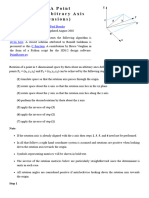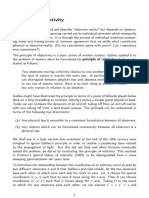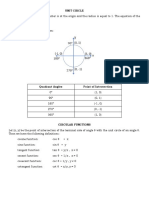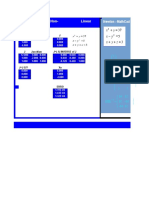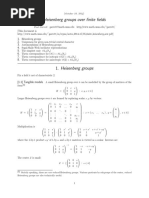02 Rotation Matrices
Uploaded by
soltean02 Rotation Matrices
Uploaded by
solteanNDSU Rotation Matrices ECE 761 - JSG
Rotation Matrices
A problem we'll be looking at in two days is trying to determine where the tip of a robot is. To do this, we use
reference frames: an {X, Y, Z} axis tied to each link of the robot. As the robot moves, often times the angle of
each frame changes. Likewise, in order to go from one link to the next, a rotation and translation is required.
This lecture looks at rotation matrices.
In the {x, y, z} plane, you can rotate about any or all axis. For simplicity, we will look at three separate rotations:
Rotating about the X axis
Rotating about the Y axis, and
Rotating about the Z axis.
In addition, we will be referring to a point (P) relative to a specific reference frame. P1, for example, refers to
the {x, y, z} coordinate of point P relative to reference frame 1.
Rotation About the X Axis
Suppose you have a point P defined relative to reference frame 0
(P0). Where is this point relative to reference frame 1 if reference Z0
frame 1 is equal to reference frame 0, rotated by θ about the
x-axis? Z1
Solution:
Y1
P 1 = T 10 ⋅ P 0
x1 1 0 0 0 x0 Q
0 cos θ sin θ 0
y1 = y0 Y0
z1 0 −sin θ cos θ 0 z0
1 0 0 0 1 1
X0
X1
Rotate About the Y-Axis:
Z0
Repeat but rotate about the Y0 axis Z1
P 1 = T 10 ⋅ P 0
x1 cos θ 0 −sin θ 0 x0
0
y1 = 1 0 0 y0
Y0
z1 sin θ 0 cos θ 0 z0
Y1
1 0 0 0 1 1
X0
X1
1 May 10, 2020
NDSU Rotation Matrices ECE 761 - JSG
Rotate about the z-axis
Z0
Z1
P 1 = T 10 ⋅ P 0
x1 cos θ sin θ 0 0 x0
−sin θ cos θ 0 0
y1 = y0
Y1
z1 0 0 1 0 z0
1 0 0 0 1 1 Y0
X0
X1
Example: A point relative to the zero reference frame is (1,2,3).
1
2
P 0 =
3
1
Where is it at if you
Rotate 90 degrees about the X axis
Rotate 90 degrees about the X axis
Rotate 90 degrees about the X axis
Solution: For convenience, define c and s to be the sine and cosine of 90 degrees:
c = cos(90*pi/180);
s = sin(90*pi/180);
From the above equations
Rx = [1,0,0,0;0,c,s,0;0,-s,c,0;0,0,0,1];
Ry = [c,0,-s,0;0,1,0,0;s,0,c,0;0,0,0,1];
Rz = [c,s,0,0;-s,c,0,0;0,0,1,0;0,0,0,1];
P0 = [1;2;3;1]
Rx * P0
Ry * P0
Rz * P0
2 May 10, 2020
NDSU Rotation Matrices ECE 761 - JSG
No Rotation X Axis Y Axis Z Axis
1 1 -3 2
2 3 2 -1
3 -2 1 3
Example 2: Where is the point if you
Rotate 20 degrees about the Y axis, then
Rotate 30 degrees about the Z axis?
Define three transformations. The point relative to reference frame 0 is
cos 20 0 0 sin 20 0 0 1
0 2
P 1 = T 10 ⋅ P 0 =
0 1 0
−sin 20 0 0 cos 20 0 0 3
0 0 0 1 1
cos 30 0 −sin 30 0 0 0
sin 30 0 cos 30 0 0 0
P 2 = T 21 ⋅ P 1 = ⋅ P1
0 0 1 0
0 0 0 1
or in MATLAB
c = cos(20*pi/180);
s = sin(20*pi/180);
Rx = [1,0,0,0;0,c,s,0;0,-s,c,0;0,0,0,1];
Ry = [c,0,-s,0;0,1,0,0;s,0,c,0;0,0,0,1];
Rz = [c,s,0,0;-s,c,0,0;0,0,1,0;0,0,0,1];
T10 = Ry;
c = cos(30*pi/180);
s = sin(30*pi/180);
Rx = [1,0,0,0;0,c,s,0;0,-s,c,0;0,0,0,1];
Ry = [c,0,-s,0;0,1,0,0;s,0,c,0;0,0,0,1];
Rz = [c,s,0,0;-s,c,0,0;0,0,1,0;0,0,0,1];
T21 = Rz;
P0 = [1;2;3;1]
P1 = T10 * P0
P2 = T21 * P1
3 May 10, 2020
NDSU Rotation Matrices ECE 761 - JSG
The point relative to the zero reference frame is:
P0 =
1
2
3
1
The point relative to the first reference frame (rotated 20 degrees about the y axis)
P1 =
-0.0864
2.0000
3.1611
1.0000
The point relative to the second reference frame (finally rotated 30 degrees about the z axis)
P2 =
0.9252
1.7752
3.1611
1.0000
0.9252
In the rotated coordinate system, the point is located at P 2 = 1.7752 .
3.1611
Displaying a 3D Object
To illustrate the use of rotation matrices, let's draw an arrow and then
Rotate the camera about the X, Y, and Z axis, then
Rotate the arrow about the X, Y, and Z axis
Define the arrow by eight points:
x 0 0 0 0 0 0 0 0
Arrow = y = −0.5 0.5 0.5 1 0 −1 −0.5 −0.5
z 0 0 0.5 0.5 1 0.5 0.5 0
Plotted on the YZ plans looks like this:
4 May 10, 2020
NDSU Rotation Matrices ECE 761 - JSG
1.5
0.5
0
-1.5 -1 -0.5 0 0.5 1 1.5 Y
Since the screen is 2-dimensional, project the arrow on the YZ plane. An m-file to display a set of points (passed
in DATA) along with a transformation matrix is as follows:
function Display3D(DATA, T)
% scaling factor
s = T(4,4);
% draw the X, Y, Z axis
X = [1,0,0,1]';
Y = [0,1,0,1]';
Z = [0,0,1,1]';
O = [0,0,0,1]';
DATA = T*DATA;
T0 = T;
T0(1,4) = 0;
T0(2,4) = 0;
T0(3,4) = 0;
% transform
X0 = T0*X;
Y0 = T0*Y;
Z0 = T0*Z;
Origin = T0*O;
% display is the y-z plane
hold off;
plot([-2,2],[-2,2],'wx');
hold on;
% Project onto the YZ axis
Tx = s*[0,1,0,0];
Ty = s*[0,0,1,0];
plot(Tx*[Origin, X0], Ty*[Origin,X0], 'g');
plot(Tx*[Origin, Y0], Ty*[Origin,Y0], 'r');
plot(Tx*[Origin, Z0], Ty*[Origin,Z0], 'm');
% display the data
plot(Tx*DATA,Ty*DATA, 'b')
end
5 May 10, 2020
NDSU Rotation Matrices ECE 761 - JSG
The previous arrow looks like the following:
X = [0,0,0,0,0,0,0,0]';
Y = [-0.5,0.5,0.5,1,0,-1,-0.5,-0.5]';
Z = [0,0,0.5,0.5,1,0.5,0.5,0]';
ARROW = [X,Y,Z,0*X+1]'
0 0 0 0 0 0 0 0
-0.5000 0.5000 0.5000 1.0000 0 -1.0000 -0.5000 -0.5000
0 0 0.5000 0.5000 1.0000 0.5000 0.5000 0
1.0000 1.0000 1.0000 1.0000 1.0000 1.0000 1.0000 1.0000
T = eye(4,4);
Display3D(ARROW, T);
6 May 10, 2020
NDSU Rotation Matrices ECE 761 - JSG
Rotate the camera about the X axis
c = cos(5*pi/180);
s = sin(5*pi/180);
Rx = [1,0,0,0;0,c,s,0;0,-s,c,0;0,0,0,1];
T = eye(4,4);
for i=1:1000
T = Rx*T;
Display3D(ARROW, T);
pause(0.01);
end
Fixed Arrow, Camera Rotated 0, -30, and -60 degrees about the X axis
Note that the camera spins counter-clockwise (positive direction). This makes it look like the arrow is spinning
counter-clockwise
7 May 10, 2020
NDSU Rotation Matrices ECE 761 - JSG
Rotate the Camera About the Y Axis
Ry = [c,0,-s,0;0,1,0,0;s,0,c,0;0,0,0,1];
0.9962 0 0.0872 0
0 1.0000 0 0
-0.0872 0 0.9962 0
0 0 0 1.0000
T = eye(4,4);
for i=1:1000
T = Ry*T;
Display3D(ARROW, T);
pause(0.01);
end
Fixed Arrow, Camera Rotated 0, 30, and 60 degrees about the Y axis
8 May 10, 2020
NDSU Rotation Matrices ECE 761 - JSG
Rotate the Camera About the Z Axis
Rz = [c,-s,0,0;s,c,0,0;0,0,1,0;0,0,0,1]
0.9962 -0.0872 0 0
0.0872 0.9962 0 0
0 0 1.0000 0
0 0 0 1.0000
T = eye(4,4);
for i=1:1000
T = Tz*T;
Display3D(ARROW, T);
pause(0.01);
end
Fixed Arrow, Camera Rotated 0, 30, and 60 degrees about the Z axis
9 May 10, 2020
NDSU Rotation Matrices ECE 761 - JSG
3D Perspective:
Move the camera 45 degrees about the Z axis then 25 degrees about the Y axis
c = cos(-25*pi/180);
s = sin(-25*pi/180);
Ry = [c,0,-s,0;0,1,0,0;s,0,c,0;0,0,0,1];
c = cos(-45*pi/180);
s = sin(-45*pi/180);
Rz = [c,-s,0,0;s,c,0,0;0,0,1,0;0,0,0,1]
Tdisp = Ry*Rz
0.6409 0.6409 0.4226 0
-0.7071 0.7071 0 0
-0.2988 -0.2988 0.9063 0
0 0 0 1.0000
Display3D(ARROW,Tdisp);
Viewing the arrow on the YX plane from an angle of Rotate Z 45 deg then Rotate Y 45 deg
10 May 10, 2020
NDSU Rotation Matrices ECE 761 - JSG
Rotate the Arrow About the X Axis
You can also rotate the object while keeping the axis fixed
c = cos(5*pi/180);
s = sin(5*pi/180);
Rx = [1,0,0,0;0,c,s,0;0,-s,c,0;0,0,0,1];
T01 = inv(Rx);
T = eye(4,4);
for i=1:1000
T = T01*T;
Display3D(T*ARROW, Tdisp);
pause(0.01);
end
Rotate the Object by 0, 45, and 90 degrees about the X axis
Note: The arrow positions are relative to reference frame 1:
P1
Relative to the zero reference frame, the points are:
P 0 = T 01 P 1
P 0 = (T 10 ) −1 P 1
11 May 10, 2020
NDSU Rotation Matrices ECE 761 - JSG
Rotate the Object About the Y Axis
c = cos(5*pi/180);
s = sin(5*pi/180);
Ry = [c,0,-s,0;0,1,0,0;s,0,c,0;0,0,0,1];
T01 = inv(Ry);
T = eye(4,4);
for i=1:1000
T = T01*T;
Display3D(T*ARROW, Tdisp);
pause(0.01);
end
Rotate the Object 0, 45, and 90 degrees about the Y axis
12 May 10, 2020
NDSU Rotation Matrices ECE 761 - JSG
Rotate the Object About the Z Axis
c = cos(5*pi/180);
s = sin(5*pi/180);
Rz = [c,s,0,0;-s,c,0,0;0,0,1,0;0,0,0,1];
T01 = inv(Rz);
T = eye(4,4);
for i=1:1000
T = T01*T;
Display3D(T*ARROW, Tdisp);
pause(0.01);
end
Rotate the Object 0, 45, and 90 Degrees About the Z Axis
13 May 10, 2020
You might also like
- Quiz No 2 Flexo Tension-Torsion 3d Portico OKNo ratings yetQuiz No 2 Flexo Tension-Torsion 3d Portico OK5 pages
- To Set Up and Study Various Logic Gates Using Diode: ObjectivesNo ratings yetTo Set Up and Study Various Logic Gates Using Diode: Objectives7 pages
- 1 What Is Log-Linearization? Some Basic Results 2 2 Application: The Baseline RBC Model 4No ratings yet1 What Is Log-Linearization? Some Basic Results 2 2 Application: The Baseline RBC Model 46 pages
- CAP4730: Computational Structures in Computer Graphics: 3D TransformationsNo ratings yetCAP4730: Computational Structures in Computer Graphics: 3D Transformations48 pages
- UNIT CIRCLE and Graph of Trigonometric FunctionsNo ratings yetUNIT CIRCLE and Graph of Trigonometric Functions4 pages
- Newton-Raphson For Non-Linear Systems Jacobian Newton - Mathcad Solution To A Non-Linear System of EquationsNo ratings yetNewton-Raphson For Non-Linear Systems Jacobian Newton - Mathcad Solution To A Non-Linear System of Equations2 pages
- Linear Algebra and SVD: (Some Slides Adapted From Octavia Camps)No ratings yetLinear Algebra and SVD: (Some Slides Adapted From Octavia Camps)24 pages
- Rigid Motion and Homogeneous Transformation PDFNo ratings yetRigid Motion and Homogeneous Transformation PDF9 pages
- 41695-7. Three Dimensional Geometric & Modeling TransformationsNo ratings yet41695-7. Three Dimensional Geometric & Modeling Transformations5 pages
- Addis Ababa Science and Technology University (Aastu) Industrial Automation and Introduction To RoboticsNo ratings yetAddis Ababa Science and Technology University (Aastu) Industrial Automation and Introduction To Robotics47 pages
- CAP4730: Computational Structures in Computer Graphics: 3D Transformations100% (1)CAP4730: Computational Structures in Computer Graphics: 3D Transformations49 pages
- EEE201-4-Basic and Universal Logic Gates, Logic CircuitsNo ratings yetEEE201-4-Basic and Universal Logic Gates, Logic Circuits11 pages
- Model, Motion Planning and Control of UR10: Universit e de Montpellier - LIRMMNo ratings yetModel, Motion Planning and Control of UR10: Universit e de Montpellier - LIRMM15 pages
- Homogeneous Representation: V V cosθ sinθ sinθ cosθ P P V V V V 1 0 0 0 cosθ sinθ 0 sinθ cosθ 1 P P 1 V VNo ratings yetHomogeneous Representation: V V cosθ sinθ sinθ cosθ P P V V V V 1 0 0 0 cosθ sinθ 0 sinθ cosθ 1 P P 1 V V8 pages
- ECE 761 Advanced Controls: Robotics (3cr) : Course InformationNo ratings yetECE 761 Advanced Controls: Robotics (3cr) : Course Information3 pages
- Matlab Review: Becoming Familiar With MATLABNo ratings yetMatlab Review: Becoming Familiar With MATLAB13 pages
- ECE 415, Fall 2003 Problem Set #1: Issued: September 2nd Due: September 9thNo ratings yetECE 415, Fall 2003 Problem Set #1: Issued: September 2nd Due: September 9th2 pages
- Chapter 1: Basic Definitions: Plane Motion Angular Velocity Angular AccelerationNo ratings yetChapter 1: Basic Definitions: Plane Motion Angular Velocity Angular Acceleration17 pages
- 3D Transformation-Edited - Compatibility ModeNo ratings yet3D Transformation-Edited - Compatibility Mode32 pages
- Exercise - 1 Objective Problems - JEE Main: Section ANo ratings yetExercise - 1 Objective Problems - JEE Main: Section A44 pages
- MIT Physics Mechanics Notes Chapter21 Rotation Translation Dynamics v06100% (1)MIT Physics Mechanics Notes Chapter21 Rotation Translation Dynamics v0629 pages
- 08 1 Horizontal and Vertical Circular MotionNo ratings yet08 1 Horizontal and Vertical Circular Motion14 pages
- ap-phys1_rotational-motion-multiple-choice_2024-11-08No ratings yetap-phys1_rotational-motion-multiple-choice_2024-11-0818 pages
- Concept Strengthening Sheet (CSS-06) Based on AIATS-06 (CF+OYM)_PhysicsNo ratings yetConcept Strengthening Sheet (CSS-06) Based on AIATS-06 (CF+OYM)_Physics4 pages
- Mechanics of MACHINES (ME3112) : Tutorial 1-2No ratings yetMechanics of MACHINES (ME3112) : Tutorial 1-216 pages
- Abstract On Design A Self Balancing BicycleNo ratings yetAbstract On Design A Self Balancing Bicycle1 page
- To Set Up and Study Various Logic Gates Using Diode: ObjectivesTo Set Up and Study Various Logic Gates Using Diode: Objectives
- 1 What Is Log-Linearization? Some Basic Results 2 2 Application: The Baseline RBC Model 41 What Is Log-Linearization? Some Basic Results 2 2 Application: The Baseline RBC Model 4
- CAP4730: Computational Structures in Computer Graphics: 3D TransformationsCAP4730: Computational Structures in Computer Graphics: 3D Transformations
- Newton-Raphson For Non-Linear Systems Jacobian Newton - Mathcad Solution To A Non-Linear System of EquationsNewton-Raphson For Non-Linear Systems Jacobian Newton - Mathcad Solution To A Non-Linear System of Equations
- Linear Algebra and SVD: (Some Slides Adapted From Octavia Camps)Linear Algebra and SVD: (Some Slides Adapted From Octavia Camps)
- 41695-7. Three Dimensional Geometric & Modeling Transformations41695-7. Three Dimensional Geometric & Modeling Transformations
- Addis Ababa Science and Technology University (Aastu) Industrial Automation and Introduction To RoboticsAddis Ababa Science and Technology University (Aastu) Industrial Automation and Introduction To Robotics
- CAP4730: Computational Structures in Computer Graphics: 3D TransformationsCAP4730: Computational Structures in Computer Graphics: 3D Transformations
- EEE201-4-Basic and Universal Logic Gates, Logic CircuitsEEE201-4-Basic and Universal Logic Gates, Logic Circuits
- Model, Motion Planning and Control of UR10: Universit e de Montpellier - LIRMMModel, Motion Planning and Control of UR10: Universit e de Montpellier - LIRMM
- Homogeneous Representation: V V cosθ sinθ sinθ cosθ P P V V V V 1 0 0 0 cosθ sinθ 0 sinθ cosθ 1 P P 1 V VHomogeneous Representation: V V cosθ sinθ sinθ cosθ P P V V V V 1 0 0 0 cosθ sinθ 0 sinθ cosθ 1 P P 1 V V
- Transformation of Axes (Geometry) Mathematics Question BankFrom EverandTransformation of Axes (Geometry) Mathematics Question Bank
- ECE 761 Advanced Controls: Robotics (3cr) : Course InformationECE 761 Advanced Controls: Robotics (3cr) : Course Information
- ECE 415, Fall 2003 Problem Set #1: Issued: September 2nd Due: September 9thECE 415, Fall 2003 Problem Set #1: Issued: September 2nd Due: September 9th
- Chapter 1: Basic Definitions: Plane Motion Angular Velocity Angular AccelerationChapter 1: Basic Definitions: Plane Motion Angular Velocity Angular Acceleration
- Exercise - 1 Objective Problems - JEE Main: Section AExercise - 1 Objective Problems - JEE Main: Section A
- MIT Physics Mechanics Notes Chapter21 Rotation Translation Dynamics v06MIT Physics Mechanics Notes Chapter21 Rotation Translation Dynamics v06
- ap-phys1_rotational-motion-multiple-choice_2024-11-08ap-phys1_rotational-motion-multiple-choice_2024-11-08
- Concept Strengthening Sheet (CSS-06) Based on AIATS-06 (CF+OYM)_PhysicsConcept Strengthening Sheet (CSS-06) Based on AIATS-06 (CF+OYM)_Physics









